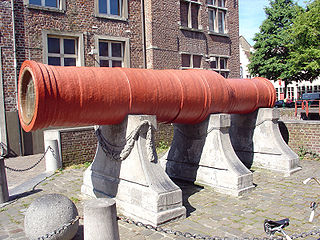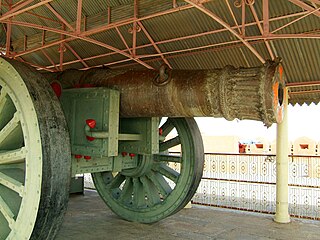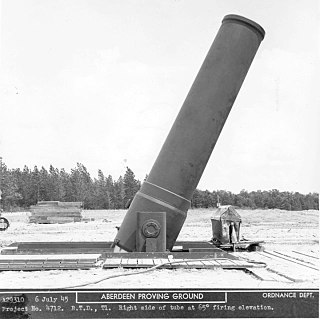 W
WThe Amiens Gun is a German 28-centimetre (11 in) railway gun that was captured by the Australian Imperial Force during World War I and returned to Australia as a war trophy. The 28 cm SK L/40 "Bruno" gun was placed on public display on 26 March 1920 adjacent to the Central railway station, Sydney. While the gun's carriage was scrapped during the 1960s, the gun barrel remains on display at the Australian War Memorial in Canberra.
 W
WThe Basilic, or The Ottoman Cannon was a very large-calibre cannon designed by Urban, a cannon engineer, Saruca Usta and architect Muslihiddin Usta at a time when cannons were still new. It is considered one of the largest cannons ever built.
 W
WThe Bibi Mariam Cannon is a large early modern artillery piece on display on the grounds of the Osmani Udyan in Dhaka, Bangladesh. The cannon dates from the 17th century.
 W
WThe Boxted Bombard is a 15th-century cannon from England. The bombard is medium in size for its type, its military use is unknown due to a lack of historical records. For a long time unlocated, the piece was rediscovered for the public at the village of Boxted in the 1970s and is now on display at the artillery collection at Fort Nelson.
 W
WThe Basillica or Great Turkish Bombard is a 15th-century siege cannon, specifically a super-sized bombard, which saw action in the 1807 Dardanelles operation. It was built in 1464 by Turkish military engineer Munir Ali and modelled after the Orban bombard that was used for the Ottoman besiegers of Constantinople in 1453.
 W
WThe double-barreled cannon is an American Civil War-era experimental weapon and is now a modern landmark located in Athens, Georgia. While originally built for warfare, the cannon never saw battle.
 W
WThe Dulle Griet is a medieval large-calibre gun founded in Gent (Ghent).
 W
WThe Faule Grete was a medieval large-calibre cannon of the Teutonic Order. The bronze bombard was cast in 1409 in the cannon foundry of the Marienburg by the gunfounder Heynrich Dumechen. According to the account books of the order, the construction costs amounted to 278.5 Mark, a sum equivalent to ca. 1160 oxen.
 W
WThe Faule Mette or Faule Metze was a medieval large-calibre cannon of the city of Brunswick, Germany.
 W
WThe Griffin cannon, also called Vogel Greif,, is one of the largest cannons from the 16th century. Since 1984, it has been in display in the Ehrenbreitstein Fortress in Koblenz. The possession of the cannon moved several times between Germany and France and became a symbol of the Franco-German reconciliation.
 W
WThe Hartshorn Memorial Cannon is a decommissioned American Civil War naval cannon that forms the centerpiece of the South Lyndeborough Village Common in Lyndeborough, New Hampshire. The cannon is named for John Alonzo Hartshorn, the town's second Civil War casualty and a former member of the town's Lafayette Artillery Company.
 W
WThe Heilongjiang hand cannon or hand-gun is a bronze hand cannon manufactured no later than 1288 and is the world's oldest confirmed surviving firearm. It weighs 3.55 kg and is 34 centimeters long. The Heilongjiang hand cannon was excavated during the 1970s in Banlachengzi, a village in Acheng District, Heilongjiang province, China. It was found alongside other bronze artifacts made in the style of the Jurchen Jin Dynasty. The hand cannon was probably used in battles fought nearby Banlachengzi in 1287 and 1288. The History of Yuan states that a Jurchen commander by the name of Li Ting led a group of soldiers equipped with hand cannons into a military camp in 1288, as part of an anti-rebellion campaign for the Yuan dynasty. The cannon currently resides at the Heilongjiang Provincial Museum in Harbin, China.
 W
WJahan Kosha Cannon literally means the Destroyer of the World. It is placed in the Topekhana a quarter of mile to the south east of the Katra Mosque, in the town of Murshidabad, West Bengal, India. Topekhana was the Nawab's Artillery Park and the entrance gate of the old capital of Bengal, Bihar and Orissa, the city of Jahangir Nagar. It is protected on the east by the Gobra Nala, locally known as the Katra Jheel. Here, the Jahan Kosha Cannon is laid to rest. Before being placed at its current location, it rested on a carriage with wheels and was surrounded by the roots of a Peepal tree. The growth of the tree roots gradually lifted the gun four feet above the ground. The wheels of the gun carriage have disappeared, but the iron-work of the carriage and the trunions are still visible. The cannon is made of ashtadhatu or 8 metals, namely silver, gold, lead, copper, zinc, tin, iron and mercury.
 W
WThe Jaivana Cannon is a large 18th-century cannon preserved at Jaigarh Fort, in Rajasthan, India. At the time of its manufacture in 1720, it was the world's largest cannon on wheels of the Early Modern Era.
 W
WLittle David was the nickname of an American 36-inch caliber mortar used for test-firing aerial bombs during World War II. With the same calibre as the British Mallet's Mortar, constructed in May 1857, it is one of the largest-calibre guns ever built, having a larger calibre than both of Germany's Schwerer Gustav and Dora which were 31.5-inch (800 mm) railway guns.
 W
WThe Malik-E-Maidan also Malik-i-Maidan or, is a large early 16th century cannon, located at Burj-E-Sherz, Bijapur Fort, Bijapur, India.
 W
WMallet's Mortar was a British shell-firing mortar built for the Crimean War, but never used in combat.
 W
WMons Meg is a medieval bombard in the collection of the Royal Armouries, but on loan to Historic Scotland and located at Edinburgh Castle in Scotland. It has a barrel diameter of 20 inches (510 mm) making it one of the largest cannons in the world by calibre.
 W
WThe Paris Gun was the name given to a type of German long-range siege gun, several of which were used to bombard Paris during World War I. They were in service from March to August 1918. When the guns were first employed, Parisians believed they had been bombed by a high-altitude Zeppelin, as the sound of neither an aeroplane nor a gun could be heard. They were the largest pieces of artillery used during the war by barrel length, and qualify under the (later) formal definition of large-calibre artillery. Also called the "Kaiser Wilhelm Geschütz", they were often confused with Big Bertha, the German howitzer used against Belgian forts in the Battle of Liège in 1914; indeed, the French called them by this name as well. They were also confused with the smaller "Langer Max" cannon, from which they were derived; although the famous Krupp-family artillery makers produced all these guns, the resemblance ended there.
 W
WPhaya Tani is a 17th-century siege cannon from Pattani Province in southern Thailand. It is the largest cannon ever cast in what is now Thailand, measuring 2.7 m long and made of brass. It is on display in front of the Ministry of Defence, opposite the Grand Palace in Bangkok. The cannon still serves as the symbol of Pattani Province and it has been on the official seal of Pattani Province since 1939.
 W
WThe Pumhart von Steyr is a medieval large-calibre cannon from Styria, Austria, and the largest known wrought-iron bombard by caliber. It weighs around 8 tons and has a length of more than 2.5 meters. It was produced in the early 15th century and could fire, according to modern calculations, an 80 cm stone ball weighing 690 kg to a distance of roughly 600 m after being loaded with 15 kg of gunpowder and set at an elevation of 10°.
 W
WQueen Elizabeth's Pocket Pistol is a cannon built in 1544 in Utrecht by Jan Tolhuys, before Elizabeth I came to the throne. The gun was presented to Henry VIII by Maximiliaan van Egmond, Count of Buren and Stadtholder of Friesland as a gift for his young daughter Elizabeth.
 W
WSchwerer Gustav was a German 80-centimetre (31.5 in) railway gun. It was developed in the late 1930s by Krupp in Rügenwalde as siege artillery for the explicit purpose of destroying the main forts of the French Maginot Line, the strongest fortifications in existence at the time. The fully assembled gun weighed nearly 1,350 tonnes, and could fire shells weighing 7 t to a range of 47 km (29 mi). The gun was designed in preparation for the Battle of France, but was not ready for action when the battle began, and in any case the Wehrmacht's Blitzkrieg offensive through Belgium rapidly outflanked and isolated the Maginot Line's static defences, eventually forcing the French to flee in panic and surrender. Gustav was later deployed in the Soviet Union during the Battle of Sevastopol, part of Operation Barbarossa, where, among other things, it destroyed a munitions depot located roughly 30 m (98 ft) below ground level. The gun was moved to Leningrad, and may have been intended to be used in the Warsaw Uprising like other German heavy siege pieces, but the uprising was crushed before it could be prepared to fire. Gustav was destroyed by the Germans near the end of the war in 1945 to avoid capture by the Soviet Red Army.
 W
WThe Seri Rambai is a 17th-century Dutch cannon displayed at Fort Cornwallis in George Town, the capital city of the Malaysian state of Penang and a UNESCO World Heritage Site. It is the largest bronze gun in Malaysia, a fertility symbol and the subject of legends and prophecy.
 W
WThe Thanjavur cannon is one of the largest early modern period cannons located in Thanjavur, Thanjavur district, Tamil Nadu, India.
 W
WThe Tiro de Diu is a 16th-century siege cannon, specifically a large-calibre basilisk, which saw action in the First Siege of Diu in 1538.
 W
WThe Tsar Cannon is a large early modern period artillery piece on display on the grounds of the Moscow Kremlin. It is a monument of Russian artillery casting art, cast in bronze in 1586 in Moscow, by the Russian master bronze caster Andrey Chokhov. Mostly of symbolic impact, it was never used in a war. However, the cannon bears traces of at least one firing. Per the Guinness Book of Records it is the largest bombard by caliber in the world, and it is a major tourist attraction in the ensemble of the Moscow Kremlin.